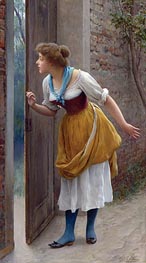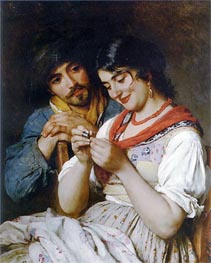
Eugen de Blaas Giclée Fine Art Prints
1843-1931
Italian Academic Classicism Painter
Eugen de Blaas was an artist who understood Venice - not just the city, but its people, its light, its intricate dance of daily life. Born in 1843 near Rome to a Tyrolean father and Italian mother, de Blaas would become one of the most recognized painters of Venetian genre scenes. His father, Karl de Blaas, a well-known painter and professor at the Academy of Venice, was instrumental in guiding his son’s early training. The family moved to Venice when Karl took up his post there, and it was in this watery city that Eugen would find the inspiration for much of his life’s work.
What set de Blaas apart from his contemporaries was his remarkable ability to capture the everyday moments of Venetian life. His works often featured local beauties - women with auburn hair, delicate lacework, and coquettish smiles. They weren’t just static figures in a romanticized landscape. Instead, they were living, breathing embodiments of the city’s spirit, like in "The Suitor" or "The Love Letter" where flirtations unfold against sun-bleached stone walls. Venice was a city of intrigue and charm, and de Blaas rendered it with an intimacy that transcended mere portraiture.
De Blaas’ mastery of Academic Classicism meant his technique was polished and precise. His paintings were often filled with sumptuous textures - silk, satin, lace - all rendered in exquisite detail. Yet, for all the technical finesse, his art had a certain warmth and accessibility. This is likely why his works were so popular, not just in Venice but across Europe and in Britain. He exhibited frequently at the Royal Academy in London and worked with prominent galleries like Arthur Tooth & Son. His popularity in England was a testament to his broad appeal - his Venetian genre scenes spoke to something universal in the human experience.
But there’s also an undercurrent of theatricality in de Blaas’ work. His "On the Balcony" (1877) is a perfect example of this - it’s not just a moment caught in time, it’s a performance. The figures are posed, almost as if they are aware of their role in the grand narrative of Venice. The backdrop of canals, gondoliers, and crumbling facades adds to this sense of timeless spectacle. His world wasn’t the quiet, delicate Venice of etchings and pastels, but a vibrant, bustling place where life played out in full color.
Eugen de Blaas passed away in 1931, leaving behind a body of work that continues to captivate. His paintings, scattered in collections across the world from Sydney to Vienna, offer a window into a Venice that still lives in the imagination - a city of beauty, allure, and endless charm.
What set de Blaas apart from his contemporaries was his remarkable ability to capture the everyday moments of Venetian life. His works often featured local beauties - women with auburn hair, delicate lacework, and coquettish smiles. They weren’t just static figures in a romanticized landscape. Instead, they were living, breathing embodiments of the city’s spirit, like in "The Suitor" or "The Love Letter" where flirtations unfold against sun-bleached stone walls. Venice was a city of intrigue and charm, and de Blaas rendered it with an intimacy that transcended mere portraiture.
De Blaas’ mastery of Academic Classicism meant his technique was polished and precise. His paintings were often filled with sumptuous textures - silk, satin, lace - all rendered in exquisite detail. Yet, for all the technical finesse, his art had a certain warmth and accessibility. This is likely why his works were so popular, not just in Venice but across Europe and in Britain. He exhibited frequently at the Royal Academy in London and worked with prominent galleries like Arthur Tooth & Son. His popularity in England was a testament to his broad appeal - his Venetian genre scenes spoke to something universal in the human experience.
But there’s also an undercurrent of theatricality in de Blaas’ work. His "On the Balcony" (1877) is a perfect example of this - it’s not just a moment caught in time, it’s a performance. The figures are posed, almost as if they are aware of their role in the grand narrative of Venice. The backdrop of canals, gondoliers, and crumbling facades adds to this sense of timeless spectacle. His world wasn’t the quiet, delicate Venice of etchings and pastels, but a vibrant, bustling place where life played out in full color.
Eugen de Blaas passed away in 1931, leaving behind a body of work that continues to captivate. His paintings, scattered in collections across the world from Sydney to Vienna, offer a window into a Venice that still lives in the imagination - a city of beauty, allure, and endless charm.
2 Eugen de Blaas Artworks

Giclée Canvas Print
$54.63
$54.63
SKU: 8382-BEU
Eugen de Blaas
Original Size:80 x 44.5 cm
Private Collection
Eugen de Blaas
Original Size:80 x 44.5 cm
Private Collection

Giclée Canvas Print
$66.39
$66.39
SKU: 8503-BEU
Eugen de Blaas
Original Size:85.1 x 68.6 cm
Private Collection
Eugen de Blaas
Original Size:85.1 x 68.6 cm
Private Collection